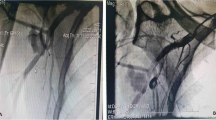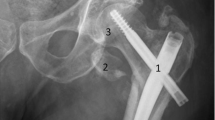Abstract
We present here a case wherein the patient developed an unsuspected pseudoaneurysm (also called a false aneurysm) secondary to a low-energy proximal humeral fracture. Massive hemorrhaging from the pseudoaneurysm occurred around 4 months from the initial injury. Neurovascular deficit and necrosis were present upon examination and the limb was unsalvageable. The delay in treatment resulted in a severe and irreversible neurovascular deficit. A shoulder disarticulation was performed and postoperative progress was favorable. Early diagnosis and surgical intervention is critical to recovery in such cases. Common features and challenges associated with this sort of injury are here described based on a review of past case reports and on our own case. Although early diagnosis is difficult, the following are some clinical features of a pseudoaneurysm secondary to a proximal humeral fracture (1) delayed presentation; (2) severe anteromedial displacement of the fracture; (3) somewhat atypical symptoms such as a recurrence or persistence of shoulder swelling and pain.




Similar content being viewed by others
References
Syed AA, Williams HR (2002) Shoulder disarticulation: a sequel of vascular injury secondary to a proximal humeral fracture. Injury 33:771–774
Hildingsson C, Toolanen G, Hedlund T (1996) Late vascular complication after fracture of the proximal humerus. Arch Orthop Trauma Surg 115:357–358
Modi CS, Nnene CO, Godsiff SP et al (2008) Axillary artery injury secondary to displaced proximal humeral fractures: a report of two cases. J Orthop Surg 16(2):243–246
van Arkel ERA, Tordoir JHM, Arens HJ (1998) A proximal humeral fracture, complicated by a pseudoaneurysm: a case report. Acta Orthop Scand 69(2):194–195
Hildingsson C, Toolanen G, Hedlund T (1996) Late vascular complication after fracture of the proximal humerus. Arch Orthop Trauma Surg 115(6):357–358
Stenning M, Drew S, Birch R (2005) Low-energy arterial injury at the shoulder with progressive or delayed nerve palsy. J Bone Joint Surg Br 87(8):1102–1106
Harris O, Roche CJ, Torreggiani WC et al (2001) Delayed presentation of pseudoaneurysm complicating closed humeral fracture: MR diagnosis. Skeletal Radiol 30:648–651
Teruo I, Yasushi I, Kenichi N et al (1997) A surgically treated case of traumatic pseudoaneurysm of axillary associated with fracture of the humeral neck. Jpn J Vasc Surg 6:757–762
Acknowledgments
No funds were received in support of this study.
Conflict of interest statement
No benefits in any form have been or will be received from a commercial party related directly or indirectly to the subject of this manuscript.
Author information
Authors and Affiliations
Corresponding author
Rights and permissions
About this article
Cite this article
Katoh, M., Iijima, Y., Ueda, Y. et al. Pseudoaneurysm of axillary artery secondary to proximal humeral fracture: clinical features. Eur J Orthop Surg Traumatol 20, 51–54 (2010). https://doi.org/10.1007/s00590-009-0493-z
Received:
Accepted:
Published:
Issue Date:
DOI: https://doi.org/10.1007/s00590-009-0493-z




